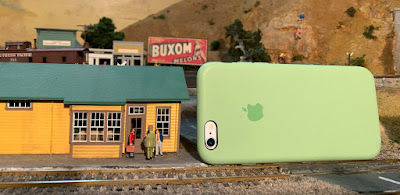The title above says it all (a phrase a friend used recently). Yes, like so many, I’ve been eagerly awaiting the situation where enough people would be vaccinated that we could break the long pandemic “outage” and have a layout operating session. This past weekend, on my layout, we got there.
It was interesting to find how much was needed, after a year or so of not operating (except small sessions with my granddaughter). Getting ready was a bigger deal than I’m used to. Projects all over the layout needed to be completed; some unused track needed to be cleaned; locomotive wheels likewise; and literally all the rolling stock on the layout and staging had to be re-evaluated for the next session. Like I said, interesting . . .
One project was to move my small scrap yard from the back of the layout to the foreground. The dark colors of the scrap pile were just a distant smudge before. Now it can be seen for what it is, tucked between Corralitos Lane and Laguna Street.
But here we are. After carefully reading the CDC guidelines for vaccinated adults, and discussing them with knowledgeable people to make sure I was reading them right, I invited my usual operators list, but making it clear the invitation was just for those who had been fully vaccinated. Dates were March 27 and 28. With full crews signed up for both days, we went ahead.
It is hard to convey how much everyone enjoyed these sessions. It was great fun for me to prepare the sessions and help solve problems during them, and everyone who operated was just so pleased to finally have a chance to do again, something we all enjoy.
The two crews the first day were as follows. First, Ed Slintak (left below) teamed with Richard Brennan. If you know Ed, you realize this is his pandemic beard. They are pictured as they started work at Ballard.
The second crew comprised Seth Neumann and Steve Van Meter, shown later as they took their turn to work at Ballard. Seth, seen below at left, is holding waybills, and Steve, who was engineer, holds an uncoupling pick.
The next day the previous session was essentially repeated with a new crew. This time, we decided to pose for a group photo (my wife was good enough to take the snap). Below, from left, it’s me, Chuck, Hakkarinen, John Sutkus, and Jon Schmidt. We’re standing alongside Shumala on the layout.
We really did have fun, the crews and me both. What a pleasure to operate again, sans masks, etc. We were just to glad to start feeling that the light at the end of the tunnel really is daylight.
Tony Thompson
















































